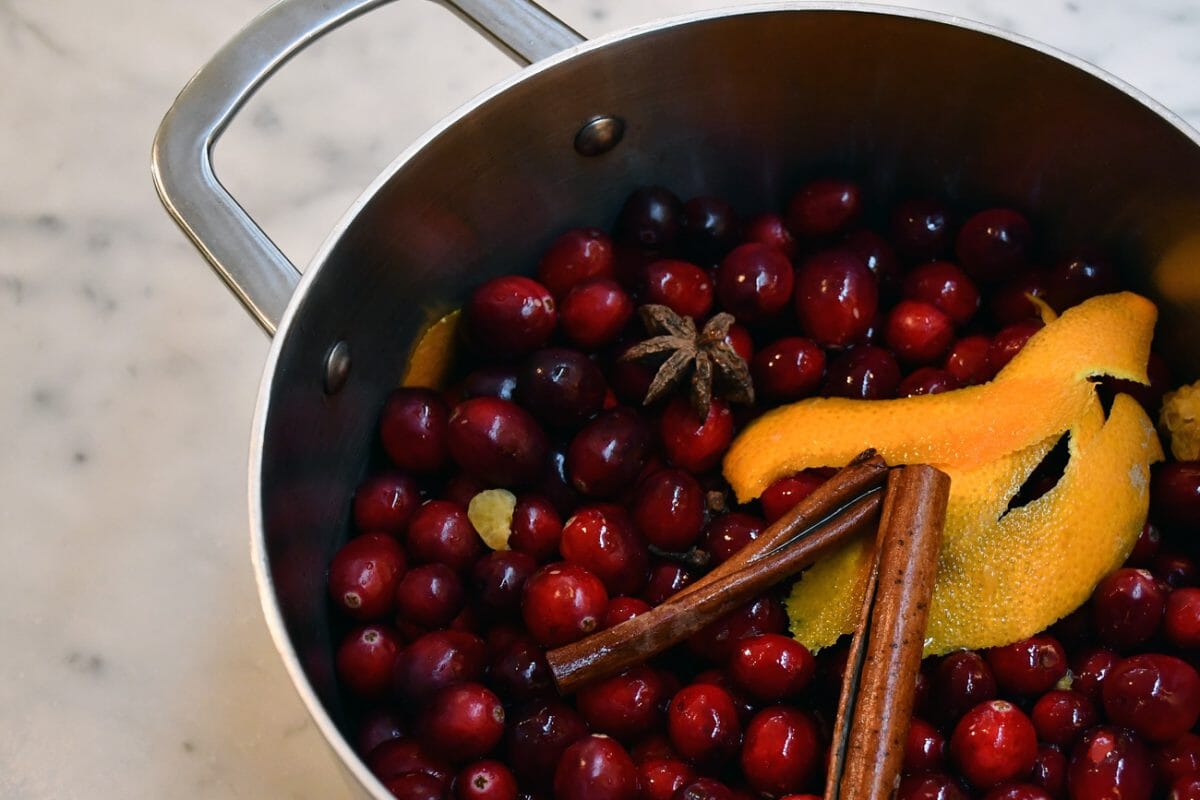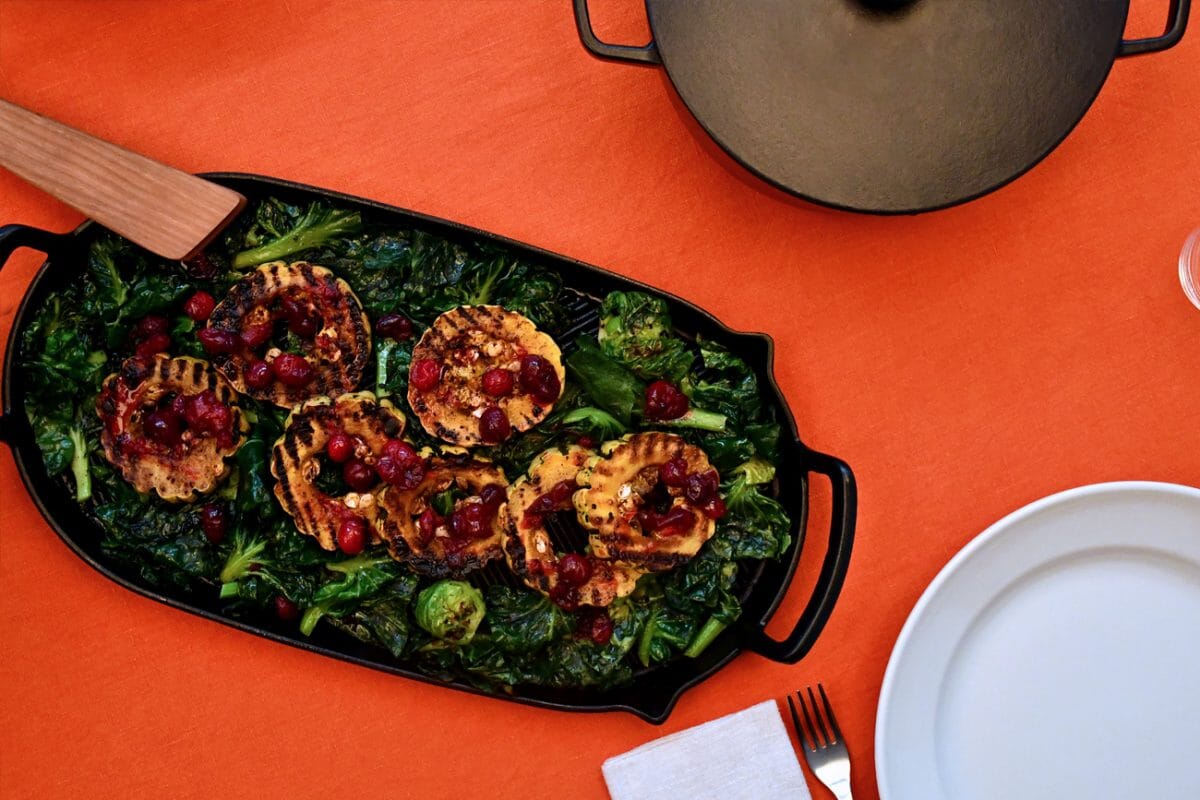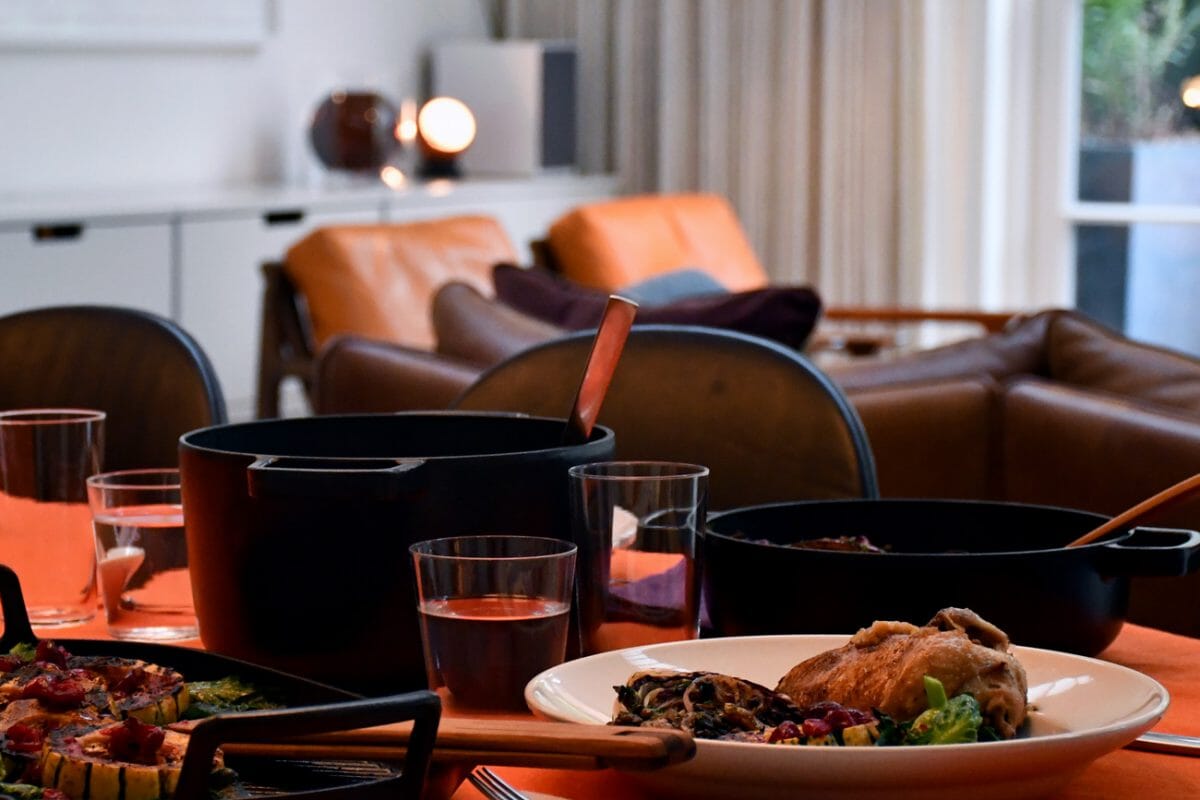These cold winter months present the ideal opportunity for getting into the kitchen and really taking the time to perfect a series of comforting, nourishing recipes that make use of high quality seasonal ingredients. Using three different items of cookware from Crane Cookware's range of ultra-stylish and hardwearing pots and pans – the C1 Casserole Dish, C2 Saute Pan and C6 Herringbone Two Hob Griddle Pan – Hanna Geller of Building Feasts has created the following winter warmer recipes, which are guaranteed to hit the spot.
Roasted squash with sprout tops, using the C6 Herringbone Two Hob Griddle Pan
Serves 4-6 as a side dish
- 1 delicata squash or 1 medium acorn squash
- 2 tbsp garlic oil (if you have any to hand) or olive oil, divided
- 1 tsp ground allspice
- 1 tsp Aleppo pepper or 1/2 tsp chili flakes
- handful of sage leaves
- salt and pepper
- 300g Sprout Tops (or Cavolo Nero / Chard / Kale)
Herb Butter
- 3 spring onions (scallions) roughly chopped (white and green parts)
- 1 small clove of garlic
- 1 small bunch of each parsley, dill and tarragon and thinly sliced chives
- zest of 1 lemon and the juice of half a lemon (approx 1 tbsp)
- salt and pepper
Make the herb butter
Chop the spring onions, garlic, herbs and lemon zest together either by hand or pulse them in the bowl of a food processor fitted with a blade. Tip the chopped herbs into a bowl and add the softened butter, lemon juice, salt and pepper and stir together with a rubber spatula or wooden spoon (or pulse a few more times together in your food processor). Place a piece of parchment paper on the worktop with the long, straight side facing you. Heap the softened butter mixture into the centre in a rough oblong shape. Roll the side of parchment closest to you over the butter mixture, encasing it completely in the paper and roll into a sausage shape. Twist the ends like a sweetie wrapper to bring the mixture together into a tight roll. Place in the fridge to chill. Then just slice and use whenever you are ready.
Grill the Squash
Preheat the oven to 190C (375F). Note: If something else is roasting in the oven at the same time at either a little higher or a little lower, do not worry, just roast the squash alongside for a few minutes more or less. The oven time is just to finish off the cooking as they are started on the hob).
Slice the delicata squash into rounds approximately 2cm thick (or into wedges if you are using any other variety) Drizzle a good glug (1 tbsp) of garlic or olive oil over the top, and sprinkle the allspice, Aleppo pepper, salt and pepper.
Heat your griddle pan until its hot but not smoking and add the squash, making sure not to cram it in too much so that it doesn’t steam. Turn the heat down to medium high and leave the squash to cook for about 5 - 8 minutes until its beginning to soften and the grill marks from the pan are well defined. Adjust the heat down slightly if they are charring too quickly.
Once they are nicely caramelised, turn them over, adding another little splash of oil to the pan or the uncooked side before turning over. Sprinkle with the sage leaves and allow to sear in the pan for a couple of minutes before transferring to the oven for 10-15 minutes to cook through.
While the squash is roasting, separate the sprout top leaves and rinse through to remove any grit. If you are using cavolo nero or kale, strip the leaves from the tough centre ribs of the greens. Blanch the greens in well salted boiling water for about 2-3 minutes until they are just cooked through but still bright green. Drain immediately and run under cold water to stop the cooking. Squeeze out any excess water with your hands and roughly chop the leaves, ready to assemble.
Take the squash out of the oven and remove onto a plate to rest for a few minutes. Place the griddle back on the hob and place all the drained and dried leaves onto the pan with 2 slices of herb butter. Toss everything together to coat the leaves in the butter as it melts. Heat until the edges of the leaves begin to catch and char a little and they are glistening. Add a little more malden salt to the top of the leaves and top with the grilled squash pieces. For a little festive weeknight cheer and colour I spoon a little cranberry sauce or for something a little more savoury, a simple salsa verde or gremolata is a fresh alternative.
Slow roast aromatic chicken, using the C1 Casserole Dish
- 4 banana shallots or 2 medium yellow onions
- 1 head of garlic, cloves separated but unpeeled
- 1 tsp ground cinnamon
- 1 tsp ground coriander
- 1/2 tsp ground ginger
- 1/2 tsp chili flakes salt and pepper
- 1 tbsp olive oil, divided
- 1 red chili
- 2 star anise
- 2 fresh bay leaves
- 1 tsp soy sauce
- 180ml - 250ml water
An hour before you want to cook the chicken, remove it from the fridge to bring it to room temperature. Preheat your oven to 160C.
Combine the cinnamon, coriander, ginger and chili flakes together in a small bowl and add the salt and pepper. Rub the spice mixture all over the dried chicken and allow to sit while you start the rest of the dish.
Drizzle over 1/2 tbsp olive oil and rub everything into the skin one more time. Peel and slice the shallots into rounds. If you are using onions, halve through the root, peel and slice into thin half moons.
Place a heavy bottomed casserole onto a medium heat, covering the bottom with the remaining 1/2tbsp olive oil. Add the sliced shallots or onions, garlic, star anise, whole chili, bay leaves and a small pinch of salt to the pan and heat until the onions are translucent and beginning to brown. Remove from the heat and place the chicken breast side down. Drizzle over the soy sauce (for colour and umami).
Just before placing in the oven add enough water to come 1/4 way up the side of the chicken. (The quantity here is vague as it depends on the size of your pan) Cook for 3 hours, turning the chicken over after the first 90 minutes and basting every 30 minutes thereafter.
Allow to rest in the pan for 20 minutes before carving or shredding off the bone and back into the sauce with the onions.
Pear and cranberry cornmeal cobbler, using the C2 Saute Pan
For the cornmeal biscuits
- 100g cold salted butter
- 100g plain flour
- 3 tbsp cornmeal (or polenta)
- 2 tbsp caster sugar
- 2 tsp baking powder
- 2 tbsp salt
- 1/2 tsp kosher salt 3 tbsp cold buttermilk
- egg wash - 1 egg and 2 tbsp whole milk Demerara sugar for sprinkling
For the filling
- 4 large firm pears
- 150g fresh cranberries (if using frozen do not defrost first)
- juice from 1 orange
- 50g light brown soft sugar
- 1 tsp vanilla extract
- 1 tsp ground cinnamon
- 1/2 tsp ground ginger
- 1/4 tsp nutmeg
- 30g crystallised ginger (optional)
Make the biscuit topping:
Grate the cold butter on the large holes of a box grater (I prefer this to cutting it into cubes, but if you would rather cube your butter, go right ahead).
Place the grated butter back in the fridge to keep it cold while you assemble the rest of the ingredients.
In a large bowl mix together the flour, cornmeal, sugar, baking powder and salt. Add the grated butter, mixing it into the flour lightly with your fingertips until it becomes a crumbly texture with large pea sized lumps of butter.
Add the buttermilk and lightly bring the dough together until it is just mixed. Do not overwork this.
Tip the just mixed dough onto a small-ish rimmed baking sheet and flatten it into a disc with the heel of your hand. You will still see pieces of butter. Cut 9 discs from the dough (about 5-7cm in diameter - a glass or a cutter works well) and place them in the freezer for an hour or two. Note: You will only need 7 for a 23cm pan but its always good to bring the scraps back together and cut a couple more just in case…..

When you are ready to bake, preheat your oven to 180C (350F).
Quarter, peel, core and slice the pears into 1cm pieces. I do this along the short side not in long lengths as I find they keep their shape a little better this way.
Place them into your baking dish of choice. Scatter the cranberries and the remaining ingredients and toss so that everything is incorporated.
Remove the biscuit discs from the freezer and place on top of the fruit, leaving a little gap in between.
Brush the top of each biscuit with the beaten egg and milk mixture and sprinkle with the Demerara sugar. Bake for 40-45 minutes until the tops are golden and the fruit is bubbling underneath.
Serve with lightly whipped cream or a dollop of creme fraiche.
Read the full Crane Cookware review.
Shop the Crane Cookware collection at OPUMO.






















